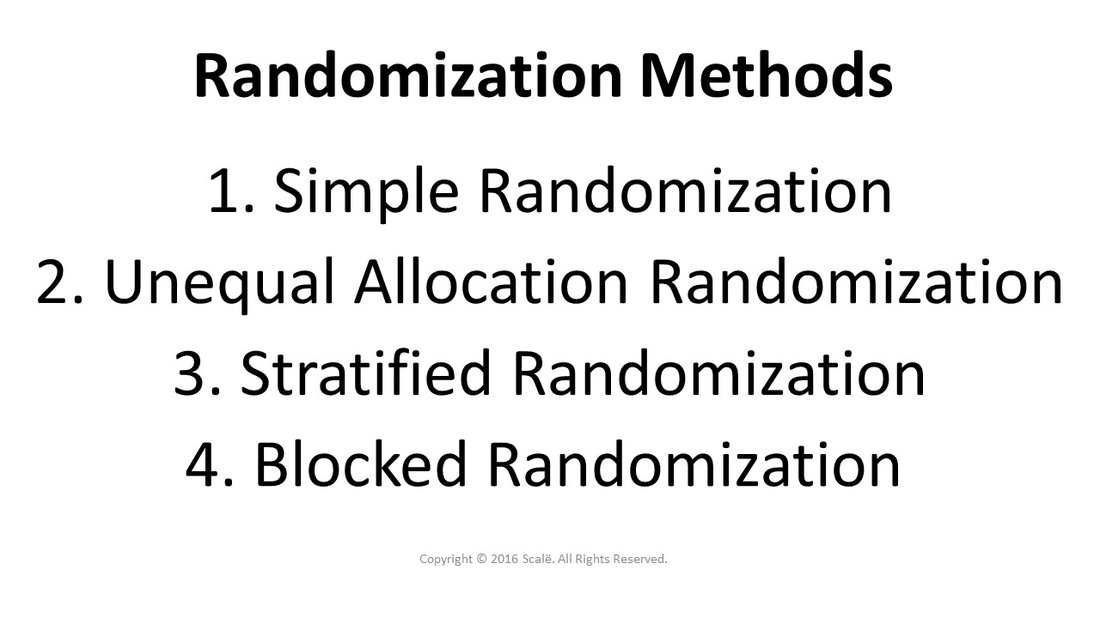Randomization Methods
Randomization methods are needed to yield causal effects, account for confounding, and reduce bias
In experimental research designs, and especially in randomized controlled trials, randomization methods are used to randomly assigned participants to either a treatment group or a control group (or multiple intervention groups). When study participants are randomly assigned to treatment groups or "arms," the groups are thought to be equal or comparable in terms of baseline characteristics. Comparable groups are needed at baseline in order to truly understand the effects of a treatment on an outcome.
Differences in baseline characteristics between treatment groups of an experimental research design can drastically bias the results (either positively or negatively). If groups are significantly different at baseline on an important variable or risk factor, multivariate statistics should be used to adjust for the differences.
There is a primary assumption associated with employing randomization in experiments. By use of randomization, the groups are thought to possess equipoise, or are assumed to be equal at baseline. Reverse causality (effect-cause) bias is also deterred when using randomized designs. Finally, randomization methods can account for both unmeasured and measured confounding variables.
There are several different methods for randomizing study participants to treatment groups in experimental research designs.
Differences in baseline characteristics between treatment groups of an experimental research design can drastically bias the results (either positively or negatively). If groups are significantly different at baseline on an important variable or risk factor, multivariate statistics should be used to adjust for the differences.
There is a primary assumption associated with employing randomization in experiments. By use of randomization, the groups are thought to possess equipoise, or are assumed to be equal at baseline. Reverse causality (effect-cause) bias is also deterred when using randomized designs. Finally, randomization methods can account for both unmeasured and measured confounding variables.
There are several different methods for randomizing study participants to treatment groups in experimental research designs.
Randomization methods in experimental research designs
Simple randomization means that participants have an equal chance of being allocated to different treatment groups. This method increases statistical power and meets the assumption of equipoise in the randomly allocated groups.
Unequal allocation randomization means randomly assigning participants into disproportionately sized groups. The acceptable ratios for unequal allocation are 2:1, 3:1, and 4:1 controls to cases. This method is useful for studying rare outcomes, adverse events, or emerging therapies. This method may lead to violations of equipoise.
Stratified randomization means randomly assigning participants to treatment groups based on predefined and objective characteristics called strata. Each stratum is randomly allocated to treatment groups.
Blocked randomization is feasible in smaller studies. Participant are randomly assigned to treatment groups in small "blocks" of four or six participants. This method ensures that there are equally sized groups and it also meets the assumption of equipoise. However, with larger populations and samples, the method becomes tedious.
Website for conducting randomization - randomizer.org
randomizer.org is an excellent and free resource for use in randomization.
Click on a button below to continue.
Statistician For Hire
DO YOU NEED TO HIRE A STATISTICIAN?
Eric Heidel, Ph.D. will provide statistical consulting for your research study at $100/hour. Secure checkout is available with PayPal, Stripe, Venmo, and Zelle.
- Statistical Analysis
- Sample Size Calculations
- Diagnostic Testing and Epidemiological Calculations
- Psychometrics

